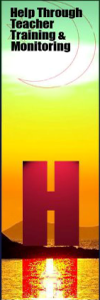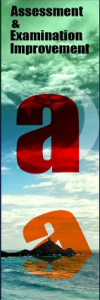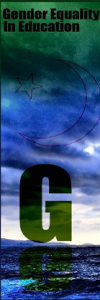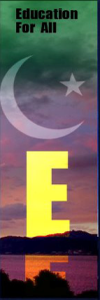“The state of Pakistan shall remove illiteracy and provide free and compulsory secondary education within minimum possible period” says the Constitution of Islamic Republic of Pakistan. In Human development Report, Pakistan is placed at 136th position for having just 49.9% educated population. The primary completion rate in Pakistan, given by Date Center of UNESCO, is 33.8% in females and 47.18% in males, which shows that people in the 6th largest country of the world are unable to get the basic education.
Estimating the value of education, Change in Education is playing a considerably important role. Over last many years, we have done some of the most exciting work in the field of literacy centers, early years’ education, ICT, curriculum, teacher training, educational standards, social and community mobilization, rural school engagement, literacy and in support of MDG’s.
Change – in Education is working to increase educational facilities and choices to the low-income and under-privileged educational neighborhoods. Increasing educational choice in low-income neighborhoods means more than opening up access to private schools. It means creating opportunity for underprivileged students across the urban and peri-urban community landscape of Pakistan to nurture the potential of custodians of our future. Along with that Change – in Education provides rural school students the same opportunities for quality education which are available to many urban schools. Following are the ares in which Change in Education is playing a significant role.

 Change – in Education has capacity and resources to develop, author and enrich school curriculum and learning programs for K-12 with focus on the local and global perspective and critical thinking thus ensuring learning outcomes in support of 21st century principles and benchmarks. With over 22 years of exposure in the educational sector, Change – in Education has an unparalleled understanding of the educational best practices that can be adapted successfully in Pakistan.”
Change – in Education has capacity and resources to develop, author and enrich school curriculum and learning programs for K-12 with focus on the local and global perspective and critical thinking thus ensuring learning outcomes in support of 21st century principles and benchmarks. With over 22 years of exposure in the educational sector, Change – in Education has an unparalleled understanding of the educational best practices that can be adapted successfully in Pakistan.” Change – in Education has capacity and resources to develop, author and enrich school curriculum and learning programs for K-12 with focus on the local and global perspective and critical thinking thus ensuring learning outcomes in support of 21st century principles and benchmarks. With over 22 years of exposure in the educational sector, Change – in Education has an unparalleled understanding of the educational best practices that can be adapted successfully in Pakistan.”
Change – in Education has capacity and resources to develop, author and enrich school curriculum and learning programs for K-12 with focus on the local and global perspective and critical thinking thus ensuring learning outcomes in support of 21st century principles and benchmarks. With over 22 years of exposure in the educational sector, Change – in Education has an unparalleled understanding of the educational best practices that can be adapted successfully in Pakistan.” Change – in Education continuously strives to reform and enrich the existing assessments and examination system to bring it at par with the student achievement and learning benchmarks. Our endeavor is to liberate the students from the tyranny of the present education system of rote learning of the irrelevant and heavy content.
Change – in Education continuously strives to reform and enrich the existing assessments and examination system to bring it at par with the student achievement and learning benchmarks. Our endeavor is to liberate the students from the tyranny of the present education system of rote learning of the irrelevant and heavy content. Change in Education’s nutrition and school health based programs are specially designed to promote healthy eating amongst students based on school policy on nutrition and sequential and coordinated curriculum, appropriate instruction for students, integration of school food service and nutrition education, staff training, family and community involvement and program evaluation, aiming to help them attain full educational potential and an overall good health. In addition, by providing them with the skills, social support, and environmental reinforcement they will adopt long-term healthy eating behaviors throughout their life.
Change in Education’s nutrition and school health based programs are specially designed to promote healthy eating amongst students based on school policy on nutrition and sequential and coordinated curriculum, appropriate instruction for students, integration of school food service and nutrition education, staff training, family and community involvement and program evaluation, aiming to help them attain full educational potential and an overall good health. In addition, by providing them with the skills, social support, and environmental reinforcement they will adopt long-term healthy eating behaviors throughout their life. In Pakistan, where there is an obvious discrimination of gender, boys are given preference in all matters and education is no different. No country can expect progress and development if a significant portion of its population does not have an education. Girls in Pakistan are left behind and are disadvantaged in education.
In Pakistan, where there is an obvious discrimination of gender, boys are given preference in all matters and education is no different. No country can expect progress and development if a significant portion of its population does not have an education. Girls in Pakistan are left behind and are disadvantaged in education. Change – in Education believes every human being is entitled to an education irrespective of class, creed, gender or ethnicity. Everyone has a right to, and should at least have access to education. “Change – in Education’s diverse portfolio of programs, its analytic work and sharing of global knowledge, following quality practice, and most importantly the passion and commitment for change in the education system benefitting all that makes it an ideal choice to deliver the promise of Education for All in Pakistan.”
Change – in Education believes every human being is entitled to an education irrespective of class, creed, gender or ethnicity. Everyone has a right to, and should at least have access to education. “Change – in Education’s diverse portfolio of programs, its analytic work and sharing of global knowledge, following quality practice, and most importantly the passion and commitment for change in the education system benefitting all that makes it an ideal choice to deliver the promise of Education for All in Pakistan.”